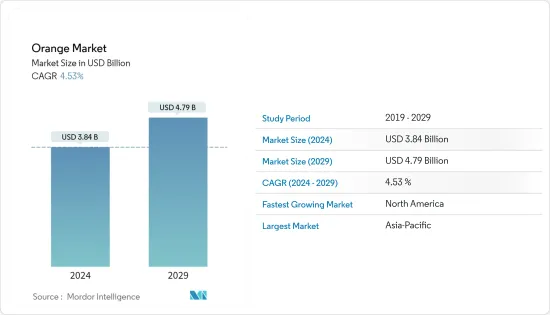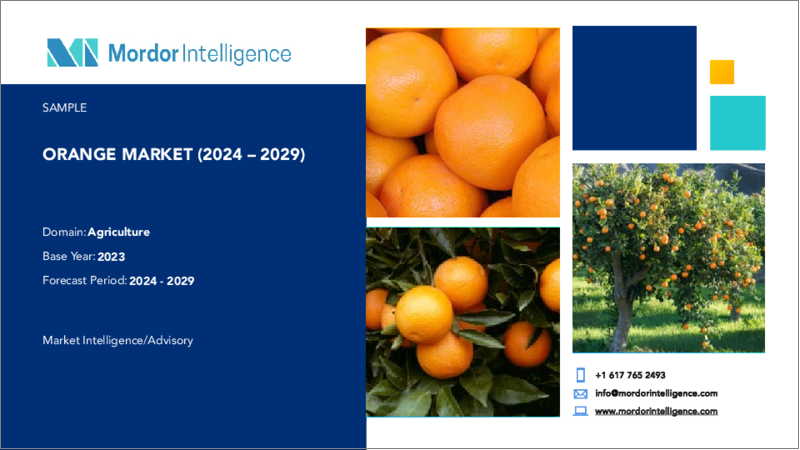|
|
市場調査レポート
商品コード
1444163
オレンジ:市場シェア分析、業界動向と統計、成長予測(2024~2029年)Orange - Market Share Analysis, Industry Trends & Statistics, Growth Forecasts (2024 - 2029) |
||||||
カスタマイズ可能
適宜更新あり
|
|||||||
| オレンジ:市場シェア分析、業界動向と統計、成長予測(2024~2029年) |
|
出版日: 2024年02月15日
発行: Mordor Intelligence
ページ情報: 英文 127 Pages
納期: 2~3営業日
|
- 全表示
- 概要
- 目次
オレンジ市場規模は2024年に38億4,000万米ドルと推定され、2029年までに47億9,000万米ドルに達すると予測されており、予測期間(2024年から2029年)中に4.53%のCAGRで成長します。

主なハイライト
- オレンジは世界の柑橘類生産の大部分に大きく貢献しており、世界の柑橘類生産量の50%以上を占め、バナナやリンゴに次いでほとんどの国で栽培されているトップの柑橘類の1つです。柑橘類の最も一般的な種は、マンダリン、スイートオレンジ、ライムです。多くのオレンジの品種や変種が地域ごとに開発されており、オーストラリアのレーン・レイト、スペインのナベレート、カリフォルニアのニューホールなど、重要なオレンジの品種がいくつかあります。
- 高い生産能力と世界中の素晴らしい気象条件がオレンジの生産に貢献しています。ただし、オレンジの生産は、環境要因、バイオストレス、政府の政策など、いくつかの要因に大きく影響されます。ブラジルは世界有数のオレンジ生産国の一つです。オレンジの国際貿易は主にブラジルや他の欧州連合諸国などの主要輸出国を中心に展開しており、オレンジの国際貿易全体のほぼ60.0%を占めています。上位の輸入国には、中国、米国、トルコなどがあります。
さらに、農務省の報告書によると、南アフリカにおける生のオレンジの生産量は、今後数年間で良好な成長率で増加すると予想されています。この増加は、主な栽培地域における収穫面積の増加と、シーズンを通して平均を上回る降雨量に基づいています。また、南アフリカは世界 100か国以上にオレンジを輸出しており、欧州連合は依然として南アフリカの最大のオレンジ輸出市場であり、総輸出量の40%以上を占めています。しかし、これらのオレンジの輸出は、近年、Citrus Black SpotとFalse Codling Mothに対するEUの懸念の影響を受けています。したがって、オレンジの生産、消費、取引の増加に伴い、世界市場は今後数年間で成長すると予想されます。
オレンジ市場動向
季節限定のオレンジ消費量の増加
オレンジの消費パターンは、人口動態、経済、気候の特徴によって異なるようです。オレンジの需要は、気温が少し低くなる11月、12月、1月がピークとなります。冬は健康上の利点があるため、オレンジの消費に非常に適しています。オレンジは自然な甘さで人気です。低カロリーで栄養価の高い柑橘類の一種で、強く透明な肌に貢献し、多くの健康状態のリスクを軽減するのに役立ちます。
その後、北米や欧州を含むさまざまな地域の消費者の好みがオレンジジュースに移りつつあります。 USDAの報告書によると、米国では、他の地域の消費者と比較して、北東部の消費者はオレンジジュースを最も強く好み、西部の消費者は新鮮なオレンジを好みます。中西部と南部の消費者は、全体的にオレンジ製品の消費量が少ないです。しかし、新鮮なオレンジの一人当たりの消費量は、その入手性の高さから、特に冬季に全国的に増加し続けています。
国連国際貿易統計データベースによると、冬季の消費量の増加により、世界へのオレンジの輸出は近年大幅に増加していますが、その消費量は国によって異なります。例えば、南アフリカからのオレンジの輸出は2021年に129万トンに達し、前年比3.2%増加しました。オレンジは群を抜いて南アフリカ最大の柑橘類であり、南アフリカの柑橘類輸出全体の約60%を占めています。また、オレンジは主に6月から9月にかけて栽培されますが、消費のピークは冬季にあります。
ブラジルは市場で重要な地位を占めている
アジア太平洋地域はオレンジの最大の市場ですが、ブラジルは注目に値する市場シェアを占めています。ブラジルは世界最大のオレンジ生産国のひとつであるにもかかわらず、オレンジの主要消費国でもあります。消費者が家庭、パン屋、レストランで絞りたてのオレンジジュースを求めているため、生のオレンジの国内消費が増加しています。また、国内で操業している工場で生産された低温殺菌ジュースも探しています。ブラジル柑橘類輸出業者協会によると、2021/2022年の同国のジュース生産量は、冷凍濃縮オレンジジュース換算で82万1,600トンに達すると予想されています。さらに、生オレンジの国内市場は、ブラジルのオレンジ総生産量の主要消費者となっています。ブラジルの生産量の約30.0%に相当する1億箱以上のオレンジ(1箱あたり40.8キログラム)がブラジル国民によって消費されています。ブラジル柑橘類輸出業者協会によると、2021/2022年には、それぞれ40.8kgの2億2,400万箱が加工に利用され、これは2020/2021年に比べて200万箱増加したことになります。
さらに、ブラジルの主要ジュース産業は、ほぼ全生産量を海外に輸出しています。季節的な消費と最終的な需要のため、冬季が始まる前は輸出が多くなります。 2022年7月から10月までの国からのオレンジジュースの輸出は、冷凍濃縮オレンジジュース換算で377.9トンでした。そのため、ブラジルではオレンジエキスや果肉を含むさまざまな果物を扱うジュース店が増加傾向にあり、国内での新鮮なオレンジの需要の増加につながっています。
オレンジ業界の概要
その他の特典
- エクセル形式の市場予測(ME)シート
- 3か月のアナリストサポート
目次
第1章 イントロダクション
- 調査の前提条件と市場の定義
- 調査範囲
第2章 調査手法
第3章 エグゼクティブサマリー
第4章 市場力学
- 市場概要
- 市場促進要因
- 市場抑制要因
- バリューチェーン分析
- バリューチェーンと価格の値上げ
- ステークホルダーの分析
第5章 市場セグメンテーション
- 地域(生産分析、金額・数量別の消費分析、金額・数量別の輸入分析、金額・数量別の輸出分析、価格動向分析)
- ブラジル
- 中国
- インド
- メキシコ
- 米国
- 欧州連合
- エジプト
- 南アフリカ
- インドネシア
- トルコ
第6章 市場機会と将来の動向
The Orange Market size is estimated at USD 3.84 billion in 2024, and is expected to reach USD 4.79 billion by 2029, growing at a CAGR of 4.53% during the forecast period (2024-2029).

Key Highlights
- Oranges contribute significantly to the bulk of the world's citrus fruit production, accounting for more than 50% of the global citrus production, and are one of the top citrus fruits grown in most countries after bananas and apples. The most common species of citrus are mandarins, sweet oranges, and limes. Many orange cultivars or varieties are developed for each region, with some important orange varieties found: Lane Late from Australia, Navelate from Spain, and Newhall from California.
- High production capabilities and magnificent weather conditions worldwide contribute to the production of oranges. However, the production of oranges is majorly affected by several factors, such as environmental factors, biostress, and government policies. Brazil is one of the major global producers of oranges. The international trade in oranges mainly revolves around major exporters, such as Brazil and other countries in the European Union, representing almost 60.0% of the total international trade in oranges. Some of the top importers are China, the United States, and Turkey.
In addition, according to the USDA report, fresh orange production in South Africa is anticipated to increase at a good growth rate in the coming years. This boost is based on the growth in harvested area and above-average rainfall throughout the season in the main growing regions. Also, South Africa exports oranges to more than 100 countries around the world, and the European Union remains South Africa's largest export market for oranges, accounting for over 40 percent of total exports. However, these orange exports have been affected by EU concerns over Citrus Black Spot and False Codling Moth in recent years. Thus, with the increased production, consumption, and trading of oranges, the global market is anticipated to grow in the coming years.
Oranges Market Trends
Growing Seasonal Consumption of Orange
Consumption patterns of oranges appear to vary by demographic, economic, and climatic characteristics. The demand for oranges is at its peak during November, December, and January when the temperatures are a little lower. The winter season is highly suitable for the consumption of oranges, owing to their health benefits. Oranges are popular due to their natural sweetness. They are a type of low-calorie, highly nutritious citrus fruit that contributes to strong, clear skin and can help lower the risk of many health conditions.
Subsequently, consumers in different regions, including North America and Europe, are shifting their preferences toward orange juice. According to a USDA report, in the United States, the Northeast consumers show the strongest preference for orange juice and those in the West for fresh oranges compared with consumers elsewhere. Consumers in the Midwest and South consume fewer orange products overall. However, the per capita consumption of fresh oranges is constantly growing across the country, particularly during the winter seasons, owing to their high availability.
According to the United Nations International Trade Statistics Database, the exports of oranges to the world have significantly increased in recent years, owing to the escalating consumption during the winter months, which varies for different countries. For instance, the export of oranges from South Africa reached 1.29 million metric tons in 2021, an increase of 3.2% from the past year. Oranges are by far South Africa's biggest citrus type and account for roughly 60% of all South Africa's citrus exports. Furthermore, oranges are primarily grown from June to September, but consumption peaks during the winter season.
Brazil Holds a Significant Market Position
Even though Asia Pacific is the largest market for oranges, Brazil possesses a noteworthy share of the market. In spite of being one of the largest producers of oranges globally, Brazil accounts for one of the leading consumers of oranges. Domestic consumption of fresh oranges is growing as consumers demand freshly squeezed orange juice in their homes, bakeries, and restaurants. They also look for pasteurized juice produced at factories operating in the country. According to the Brazilian Association of Citrus Exporters, the country's juice production in 2021/2022 is expected to be 821,600 metric tons of frozen concentrate orange juice equivalent.Further, the domestic market for fresh oranges has become a major consumer of Brazil's total orange production. More than 100.0 million boxes of oranges, each weighing 40.8 kilograms, equivalent to approximately 30.0% of Brazil's production, are consumed by the Brazilian population annually. According to the Brazilian Association of Citrus Exporters, in the year 2021/2022, 224 million boxes of 40.8 kg each were utilized for processing, which constitutes an increase of 2 million boxes from the year 2020/2021.
Additionally, major juice industries in Brazil export almost their entire production to international destinations. Due to seasonal consumption and eventual demand, exports are high prior to the onset of the winter season. The export of orange juices from the country from July to October 2022 was 377.9 metric tons of Frozen Concentrate orange juice equivalent. Hence, the growing trend of juice shops with a variety of fruits, including orange extracts and pulp, in Brazil has led to an increase in the demand for fresh oranges in the country.
Oranges Industry Overview
Additional Benefits:
- The market estimate (ME) sheet in Excel format
- 3 months of analyst support
TABLE OF CONTENTS
1 INTRODUCTION
- 1.1 Study Assumptions and Market Definition
- 1.2 Scope of the Study
2 RESEARCH METHODOLOGY
3 EXECUTIVE SUMMARY
4 MARKET DYNAMICS
- 4.1 Market Overview
- 4.2 Market Drivers
- 4.3 Market Restraints
- 4.4 Value Chain analysis
- 4.4.1 Value Chain and Price Markups
- 4.4.2 Stakeholder Analysis
5 MARKET SEGMENTATION
- 5.1 Geography (Production Analysis, Consumption Analysis by Value and Volume, Import Analysis by Value and Volume, Export Analysis by Value and Volume, and Price Trend Analysis)
- 5.1.1 Brazil
- 5.1.2 China
- 5.1.3 India
- 5.1.4 Mexico
- 5.1.5 United States
- 5.1.6 European Union
- 5.1.7 Egypt
- 5.1.8 South Africa
- 5.1.9 Indonesia
- 5.1.10 Turkey






